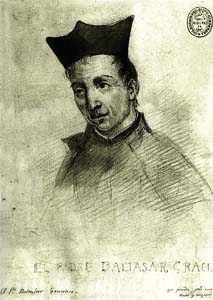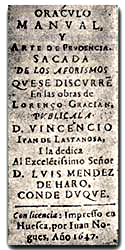Baltasar Gracian y Morales
Baltasar Gracián y Morales (January 8, 1601 - December 6, 1658), Spanish prose writer, was born in Belmonte, near Calatayud (Aragon).
Biography
The son of a doctor, in his childhood Gracián lived with his uncle, who was a priest. He studied at a Jesuit school in Zaragoza from 1616 to 1619 and at the age of 18 became a novice. He studied philosophy at the College of Calatayud in 1621 and 1623 and theology in Zaragoza. He was ordained in 1627 and took his final vows in 1635.
He assumed the vows of the Jesuits in 1633 and dedicated himself to teaching in various Jesuit schools. He spent time in Huesca, where he befriended the local scholar Vincencio Juan de Lastanosa, who helped him achieve an important milestone in his intellectual upbringing. He acquired fame as a preacher, although some of his oratorical displays, such as reading a letter sent from Hell from the pulpit, were frowned upon by his superiors. He was named Rector of the Jesuit college of Tarragona and wrote works proposing models for courtly conduct such as El héroe (The Hero), El político (The Politician), and El discreto (The Discreet One). During the Spanish war with Catalonia and France, he was chaplain of the army that liberated Lleida in 1646.
In 1651, he published the first part of the Criticón (Faultfinder) without the permission of his superiors, whom he disobeyed repeatedly. This attracted the Company's displeasure. Ignoring the reprimands, he published the third part of Criticón in 1657, and as a result was sanctioned and exiled to Graus. He tried to leave the order but was unsuccessful. He died in 1658 and is buried in Tarazona near Zaragoza in the province of Aragon.
Gracián is the most representative writer of the Spanish Baroque literary style known as Conceptismo (Conceptism), of which he was the most important theoretician; his Agudeza y arte de ingenio (Wit and the Art of Inventiveness) is at once a poetic, a rhetoric and an anthology of the conceptist style.
The Criticón
The three parts of the Criticón, published in 1651, 1653, and 1657, achieved fame in Europe, especially in the German-speaking countries. It is, without a doubt, the author's masterpiece and one of the great works of the Siglo de Oro. It is a lengthy allegorical novel with philosophical overtones. It recalls the Byzantine style of novel in its many vicissitudes and in the numerous adventures to which the characters are subjected, as well as the picaresque novel in its satirical take on society, as evidenced in the long pilgrimage undertaken by the main characters, Critilo, the "critical man" who personifies disillusionment, and Andrenio, the "natural man" who represents innocence and primitive impulses. The author constantly exhibits a perspectivist technique that unfolds according to the criteria or points of view of both characters, but in an antithetical rather than plural way as in Miguel de Cervantes. The novel reveals a philosophy, pessimism, with which one of his best readers and admirers, the 19th century German philosopher Arthur Schopenhauer, identified.
The following is a summary of the Criticón, reduced almost to the point of a sketch, of a complex work that demands detailed study.
Critilo, man of the world, is shipwrecked on the coast of the island of Santa Elena, where he meets Andrenio, the natural man, who has grown up completely ignorant of civilization. Together they undertake a long voyage to the Isle of Immortality, travelling the long and prickly road of life. In the first part, "En la primavera de la niñez" ("In the Spring of Youth"), they join the royal court, where they suffer all manner of disappointments; in the second part, "En el otoño de la varonil edad" ("In the Autumn of the Age of Manliness"), they pass through Aragon, where they visit the house of Salastano (an anagram of the name of Gracián's friend Lastanosa), and travel to France, which the author calls the "wasteland of Hipocrinda", populated entirely by hypocrites and dunces, ending with a visit to a house of lunatics. In the third part, "En el invierno de la vejez" ("In the Winter of Old Age"), they arrive in Rome, where they encounter an academy where they meet the most inventive of men, arriving finally at the Isle of Immortality.
The Art of Worldly Wisdom
Gracián's style, generically called conceptism, is characterized by ellipsis and the concentration of a maximum of significance in a minimum of form, an approach referred to in Spanish as agudeza (wit), and which is brought to its extreme in the Oráculo manual y arte de prudencia (literally The Oracle, a Manual of the Art of Discretion, commonly translated as The Art of Worldly Wisdom), which is almost entirely comprised of three hundred maxims with commentary. He constantly plays with words: each phrase becomes a puzzle, using the most diverse rhetorical devices.
Critical Reception
The 1911 Encyclopædia Britannica wrote of Gracián that "He has been excessively praised by Schopenhauer, whose appreciation of the author induced him to translate the Oráculo manual, and he has been unduly depreciated by Ticknor and others. He is an acute thinker and observer, misled by his systematic misanthropy and by his fantastic literary theories."
Works
- El héroe (1637, The Hero), a criticism of Machiavelli drawing a portrait of the ideal Christian leader.
- El político Don Fernando el Católico (1640, The Politician King Ferdinand the Catholic), presents his ideal image of the politician.
- Arte de ingenio (1642, revised as Agudeza y arte de ingenio in 1648), an essay on literature and aesthetics.
- El discreto (1646, The Complete Gentleman), described the qualities which make the sophisticated man of the world.
- Oráculo manual y arte de prudencia (1647), translated as The Art of Worldly Wisdom (by Joseph Jacobs, 1892), The Oracle, a Manual of the Art of Discretion (by L.B. Walton), Practical Wisdom for Perilous Times (in selections by J. Leonard Kaye), or The Science of Success and the Art of Prudence, his most famous book, some 300 aphorisms with comments.
- El Criticón (1651-1657), a novel, translated as The Critic by Sir Paul Rycaut in 1681.
The only publication which bears Gracián's name is El Comulgatorio (1655); his more important books were issued under the pseudonym of Lorenzo Gracián (a brother of the writer) or under the anagram of Gracía de Marlones. Gracián was punished for publishing without his superior's permission El Criticón (in which Defoe is alleged to have found the germ of Robinson Crusoe): but no objection was taken to its substance.
ReferencesISBN links support NWE through referral fees
- Gracián and Perfection by Monroe Z. Hafter (1966)
- Baltasar Gracián by Virginia R. Foster (1975)
- The Truth Disguised by Theodore L. Kassier (1976)
- This article incorporates text from the Encyclopædia Britannica Eleventh Edition, a publication now in the public domain.
- The 1911 Encyclopædia Britannica in turn gives the following references: See Karl Borinski, Baltasar Gracián und die Hoflitteratur in Deutschland (Halle, 1894); Benedetto Croce, I Trattatisti Italiani del Concettismo e Baltasar Gracián (Napoli, 1899); Narciso José Lin y Heredia, Baltasar Gracián (Madrid, 1902). Schopenhauer and Joseph Jacobs have respectively translated the Oráculo manual into German and English.
External links
- Gracián, Baltasar in The Columbia Encyclopedia, Sixth Edition, 2001.
- Baltasar Gracián biography and bibliography, from Books and Writers.
- "Gracián and the psychoanalysis", features a portrait.
- Translation of El Arte de Prudencia
- Balthasar Gracian's The Art of Worldly Wisdom
bs:Baltasar Gracián y Morales de:Baltasar Gracián es:Baltasar Gracián fr:Baltasar Gracián gl:Baltasar Gracián ko:발타사르 그라시안 he:בלטסר גרסיאן pt:Baltasar Gracián sk:Baltasar Gracián sv:Baltasar Gracián y Morales
Credits
New World Encyclopedia writers and editors rewrote and completed the Wikipedia article in accordance with New World Encyclopedia standards. This article abides by terms of the Creative Commons CC-by-sa 3.0 License (CC-by-sa), which may be used and disseminated with proper attribution. Credit is due under the terms of this license that can reference both the New World Encyclopedia contributors and the selfless volunteer contributors of the Wikimedia Foundation. To cite this article click here for a list of acceptable citing formats.The history of earlier contributions by wikipedians is accessible to researchers here:
The history of this article since it was imported to New World Encyclopedia:
Note: Some restrictions may apply to use of individual images which are separately licensed.



